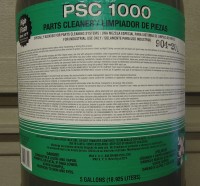Here’s my parts washer solution of choice – click on the photo to enlarge. This is a solvent-based cleaner, which I prefer over water based products. I’ve tried water based cleaners several times over the last few years, though not in my washer tank. They’ve never really satisfied me with their results and with many of them you have to be careful not to leave aluminum components immersed for too long. Otherwise, due to chemical reaction the aluminum may become discolored.
One of my main criteria for a washer solvent is safety, hence the concern with a high flash point. This particular product is commonly available and has one of the highest flash points I could find at over 141 degree Fahrenheit. That’s not to say it’s inexpensive, but cost is not concern for me in this situation; safety and cleaning ability are my priorities. This product is made by Crown, can be purchased at most Farm supply stores and I buy it at Tractor Supply (TSC). They always seem to have it in stock, at least in my local stores.
I also included below information on “flash point”, the definition and specifics on common chemicals and their respective flash points.
Flash Point – three common definitions found on the internet
1. The lowest temperature at which the vapor of a flammable liquid will ignite in air. The flash point is generally lower than the temperature needed for the liquid itself to ignite.
2. The lowest temperature at which a liquid produces enough vapor to form an ignitable mixture. Liquids with low flash points pose the greatest danger.
3. Temperature at and above which a liquid gives off enough flammable vapor to form a mixture with air that can be ignited by contact with a hot surface, spark or flame. The lower the flash point, the greater the fire hazard.
In other words, the flash point is an indication of how easy a chemical may burn. Materials with higher flash points are less flammable or hazardous than chemicals with lower flash points.
Flash Points of Common Flammable Substances
Fuel Flash Point (degree Fahrenheit)
- Acetone 0
- Diesel fuel (1-d) 100
- Ethel Alcohol 55
- Gasoline -45
- Kerosene 110
- Propane -156
Of course not all of these chemicals are suitable for parts washers, but I included a few other common chemicals such as acetone and propane to provide context. One would expect gasoline and propane to have low flash points as these are intended to be used a fuels, not cleaning agents. However, in spite of being seriously ill-advised, gasoline is commonly used in home shops and garages for parts cleaning.

Usually I do not read post on blogs, but I wish to say that this write-up very compelled me to check
out and do it! Your writing taste has been surprised me. Thank you, quite nice article.